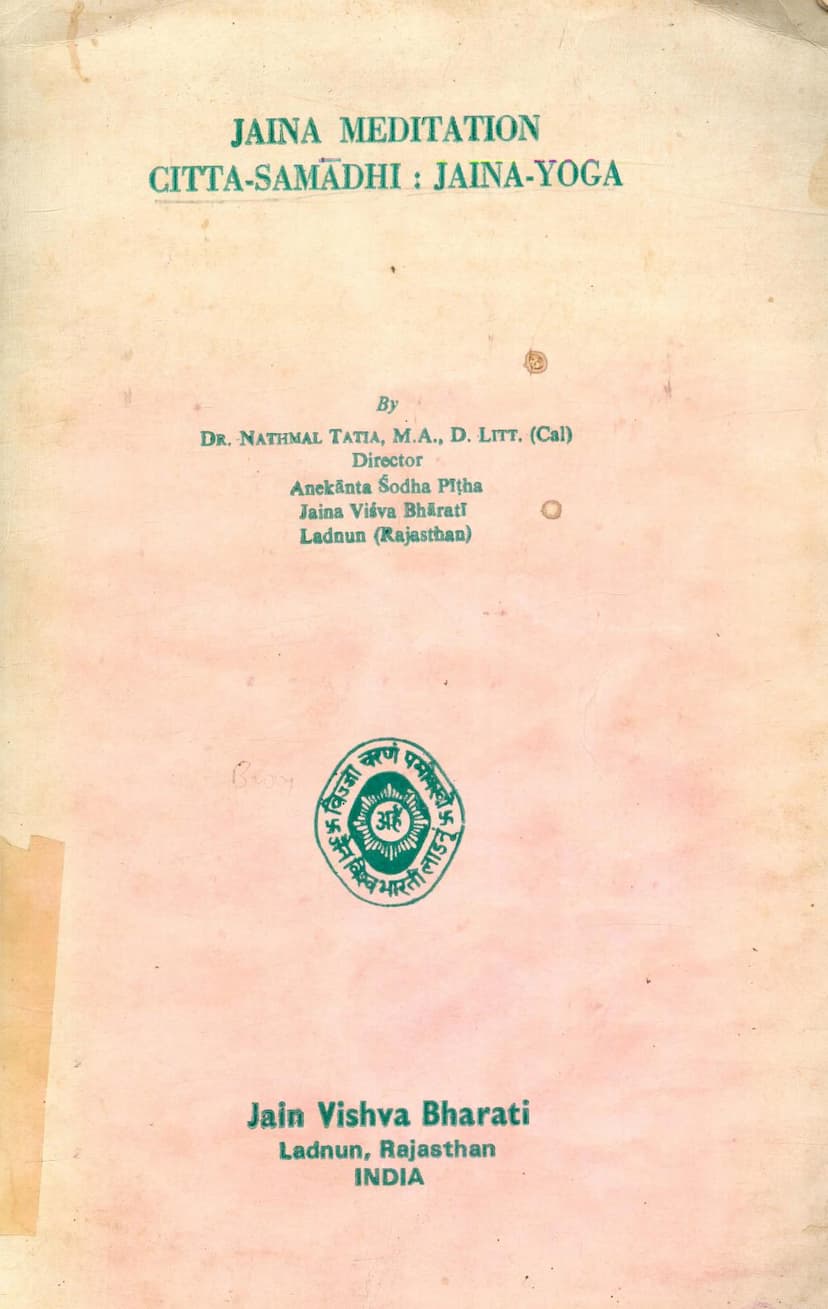Jaina Meditation Citta Samadhi Jaina Yoga
Added to library: September 2, 2025

Summary
This document is a scholarly work titled "Jaina Meditation Citta Samadhi : Jaina Yoga" by Dr. Nathmal Tatia, published by Jain Vishva Bharati. The book explores the rich tradition of meditation and yoga within Jainism, drawing upon classical Jaina texts and the works of prominent Jaina thinkers.
Here's a comprehensive summary based on the provided text:
Core Theme: The book aims to demonstrate the depth and sophistication of Jaina meditation (Dhyana) and yoga practices, refuting the common misconception that Jainism solely focuses on physical penances. It highlights Jainism's comprehensive spiritual discipline that integrates mental concentration and yogic practices for the ultimate goal of liberation (Moksha).
Key Aspects Covered:
-
Introduction to Jaina Meditation:
- Meditation has always held a significant position in Jainism, evolving through various phases.
- The Agamic literature provides insights into early meditative practices, potentially followed by Lord Mahavira himself.
- The book intends to reconstruct the early phase, present the classical theory of meditation, and then discuss later scholarly interpretations.
-
Meditation in Early Jainism:
- Physical Postures: Emphasizes the importance of specific physical postures (like kayotsarga) for meditation, involving stillness, controlled breathing, and guarded senses. These postures were considered part of kayaklesa (penance involving the body).
- Mental Qualifications: Lists numerous mental attributes crucial for successful meditation, including detachment (nirveda), concentration (ekagrata), self-control through guarding mind, speech, and body (gupti), equanimity (samadharanata), freedom from worry (akaukṛtya), pure perception (preksa), absence of passions (akasayata), enthusiasm (parakrama), vigilance (apramada), and others.
- Impediments to Meditation: Identifies doubt (vicikitsa), worry (kaukṛtya), passions (kasaya), greed (grddhi), negligence (pramada), and possessiveness (murcha) as major obstacles.
- Dhyana and Prajna: Stresses the inseparable relationship between meditation (dhyana) and wisdom/insight (prajna).
- Asubhatvanupreksa: Discusses the practice of contemplating the impurity of the body, seen as an early form of asubhanupreksa found in Jainism, Buddhism, and Patanjali's Yoga.
- Temptation of Supernatural Powers: Notes that early Jaina texts acknowledge the temptation of supernatural powers during meditation, a concept also found in Patanjali's Yoga Sutras.
- Early Jaina Meditation and Vipassana: Highlights the affinity between Mahavira's meditation and the Buddhist practice of vipassana.
-
The Classical Theory of Meditation (Chatuh-vidha Dhyana):
- The classical Jaina theory categorizes meditation into four types:
- Arta Dhyana (Sorrowful Meditation): Characterized by agony and anguish, arising from loss of desired objects, separation from loved ones, illness, or recollection of past enjoyments. It has four varieties.
- Raudra Dhyana (Fierce/Cruel Meditation): Marked by cruelty and associated with deadly sins like violence, lying, stealing, and protection of possessions with excessive attachment. It also has four varieties.
- Dharma Dhyana (Righteous Meditation): Focused on righteous contemplation, scriptural knowledge, and moral conduct. Its objects include the nature of the soul, suffering, karmic fruition, and the structure of the universe. It is supported by exposition, inquiry, study, and contemplation. It has four subtypes based on objects of contemplation, four signs of practitioners, four supporting factors, and four contemplations (anupreksa).
- Shukla Dhyana (Pure/White Meditation): The highest form of meditation, eradicating karmic impurities. It has four varieties: prthaktva-vitarka-savicari, ekatvavitarka-avicari, suksma-kriya-'nivarti, and samucchinnakriya'pratipati. This leads to omniscience and eventual liberation.
- The classical Jaina theory categorizes meditation into four types:
-
Scholastic Orientation of Classical Theory:
- Examines the contributions of key Jaina thinkers who elaborated on the classical theory:
- Siddhasena Divakara: Critically interpreted the fourfold meditation in light of Buddhist concepts, rationalizing the orthodox theory.
- Haribhadra: Made significant comparative studies of Yoga across different traditions (Jainism, Buddhism, Yoga), integrating concepts like gunasthanas (stages of spiritual development) with yogic practices. He detailed the stages of yogic development and the importance of samyagdrsti.
- Subhacandra and Hemacandra: Further elaborated on virtues, postures, breath control, sense withdrawal, and concentration, integrating these with Jain principles. Hemacandra, in particular, discussed the goal of yoga as liberation through right knowledge, attitude, and conduct.
- Yasovijaya: Revived and commented on Haribhadra's works, providing critical analyses and comparative studies.
- Examines the contributions of key Jaina thinkers who elaborated on the classical theory:
-
Comparative Analysis: The book frequently draws parallels between Jaina meditative practices and those found in Buddhism (e.g., vipassana) and Patanjali's Yoga Sutras (e.g., yama, niyama, asana, dharana, samadhi).
-
Key Jaina Texts on Meditation: The book analyzes the teachings on meditation from various significant Jaina texts and commentaries, including:
- Sthananga Sutra (with Abhayadevasuri's commentary)
- Ayaradasao (specifically the chapter on "Cittasamahitthanas" or ten stages of concentrated mind)
- Dhyanadvatrinsika of Siddhasena Divakara
- Commentary of Siddhasenagani on Umasvati's Tattvartha-Bhasya
- Dhyanasataka attributed to Jinabhadragani Ksamasramana
- Dhavala commentary of Virasenacarya
- Bhagavati Aradhana
-
Conclusion:
- Reiterates that meditation is the supreme penance in Jainism, leading to rapid spiritual progress.
- It purifies the mind and is essential for the successful observance of mahavratas (great vows).
- The progress through the gunasthanas is directly linked to the aspirant's meditative capacity.
- The virtues of maitri (friendliness), karuna (compassion), mudita (sympathetic joy), and upeksa (equanimity) are fundamental and shared across Jaina, Buddhist, and Yoga traditions.
- Social welfare and spiritual detachment are not contradictory; detachment allows for a dispassionate view beneficial for both the individual and society.
- The orthodox Jaina doctrine of meditation has historical parallels with contemporary doctrines, with later influences being a subject for further study.
In essence, "Jaina Meditation Citta Samadhi : Jaina Yoga" provides a scholarly exposition of the Jaina path of meditation, showcasing its philosophical underpinnings, practical aspects, and historical development through an analysis of key Jaina scriptures and the insights of its esteemed thinkers. It emphasizes meditation as a vital tool for spiritual transformation and liberation.